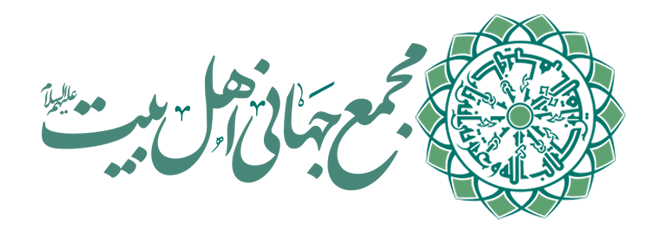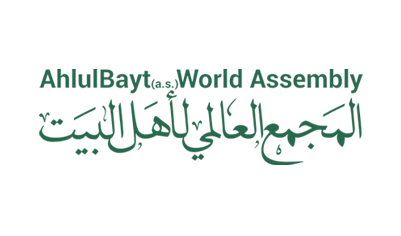Center for Revival of Islamic Heritage revives Shiite Ancient Works/ ABWA’s cooperation with servants of Shiite school
Among the tasks defined for the AhlulBayt (a.s.) World Assembly, is to preserve the Shiite heritage and works, identify capacities, and create areas of cooperation and interaction between the Assembly and Shiite centers. The Center for the Revival of Islamic Heritage, headed by Ayatollah Eshkevari, is one of the organizations that have the mission of reviving ancient Shiite works.
ABWA Official Website – Increasing communication with active centers and institutions about AhlulBayt (a.s.), as well as creating fields of cooperation and using their capacities, is the approach of the AhlulBayt (a.s.) World Assembly in the new management period. In this regard, on Sunday, June 18, 2023, a group of directors of the Assembly visited the Center for the Revival of Islamic Heritage, headed by Ayatollah Sayed Ahmad Hosseini Eshkevari.
Ayatollah Sayed Ahmad Hosseini Eshkevari is a prominent professor and researcher of Shiite works who, at 92 years old, works 24/7 for the revival of Shiite heritage with the vigor of youth. Ayatollah Eshkevari, who is just an old man at first glance, when he takes the lead for explanations about every corner of the Center for the Revival of Islamic Heritage, his will, extraordinary memory, and unparalleled mastery are completely evident.
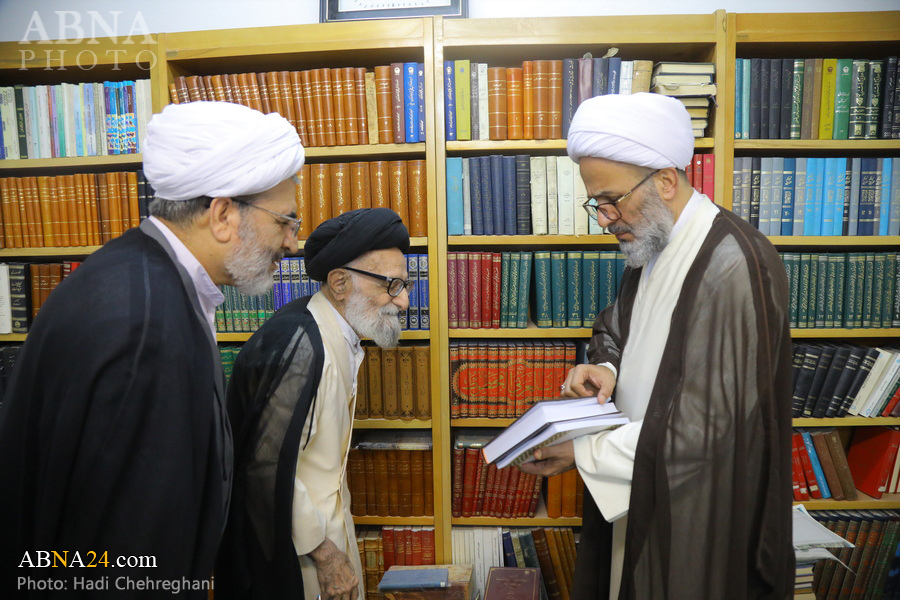
A report of the activities of the AhlulBayt (a.s.) World Assembly
At the beginning of the visit, the adviser to the Secretary General of the AhlulBayt (a.s.) World Assembly on Seminary and Clergy Affairs, presented a report on the activities of this international organization in various fields.
While considering addressing the situation of the Shiites of the world as the main mission and task of the AhlulBayt (a.s.) World Assembly, Hojat al-Islam Abdullah Tavana stated, “Among the tasks defined for the AhlulBayt (a.s.) World Assembly, is to preserve the Shiite heritage and works. Therefore, it is important to identify the capacities and create areas of cooperation and interaction between the AhlulBayt (a.s.) World Assembly and the Center for the Revival of Islamic Heritage.”
Tavana also presented a report on holding the “International Conference of Hazrat Abu Talib (a.s.); Supporter of the Great Prophet (p.b.u.h)” by the Assembly and the publication of a 25-volume encyclopedia of the works of this conference.
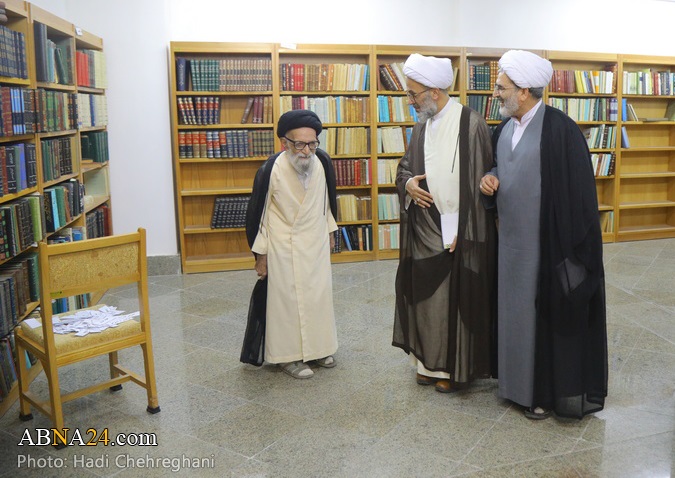
The works of the “Center for Revival of Islamic Heritage” focused on Bibliography and Shiite Ulama fields of study
Further in the visit, describing the main activities of the “Center for the Revival of Islamic Heritage”, Ayatollah Seyyed Ahmad Hosseini Eshkevari, the president and founder of the center said, “I have been engaged in heritage-related activities since the age of thirty, and in sixty years, three hundred volumes of these works have been published, eighty of which are devoted to manuscript indexes. I have traveled to many countries, and seen great libraries up close, and my recent heritage-related work, Al-Mualaffat al-Imamiyah (the Compilations of Imamiyah), will be published in 21 volumes in Karbala.”
“Most of my works are in Bibliography and Shiite Ulama fields of study,” he added, “My activities are in the Shiite framework.”
“I care a lot about discipline and order in doing works,” the Shiite bibliographer and cataloger of manuscripts added, “In addition to the publication of books, I care a lot about their distribution, and I have even paid close attention to the attractiveness of the building of the Center for the Revival of Islamic Heritage.”
On the establishment history of the Center for the Revival of the Islamic Heritage, he said, “In the Congress “Books and Bibliography in Islamic Civilization” of the Holy Shrine of Imam Reza (a.s.), in a short speech I said, “We must establish a center in which copies of Shiite books from all over the world can be photographed and made available to clerics and students. Therefore, I presented an institutional plan for this work. There, Hojat al-Islam Sayed Javad Shahrestani (representative of Ayatollah Sistani) and Mr. Aziz Tabatabai said, “This is a good suggestion, and you should do it yourself.” After discussions, the Center for Revival of Islamic Heritage was established in a basement with an area of eighteen square meters. Today, after nearly 30 years of activity, more than 200,000 copies from different countries have been photographed in this center, 12,000 manuscripts have been purchased, and 8,000 documents are also available in the center. Also, for manuscripts, 16 volumes of the Persian index have been prepared, of which the 17th volume is about to be printed. Also, for manuscripts, 9 volumes of catalogs have been printed.”
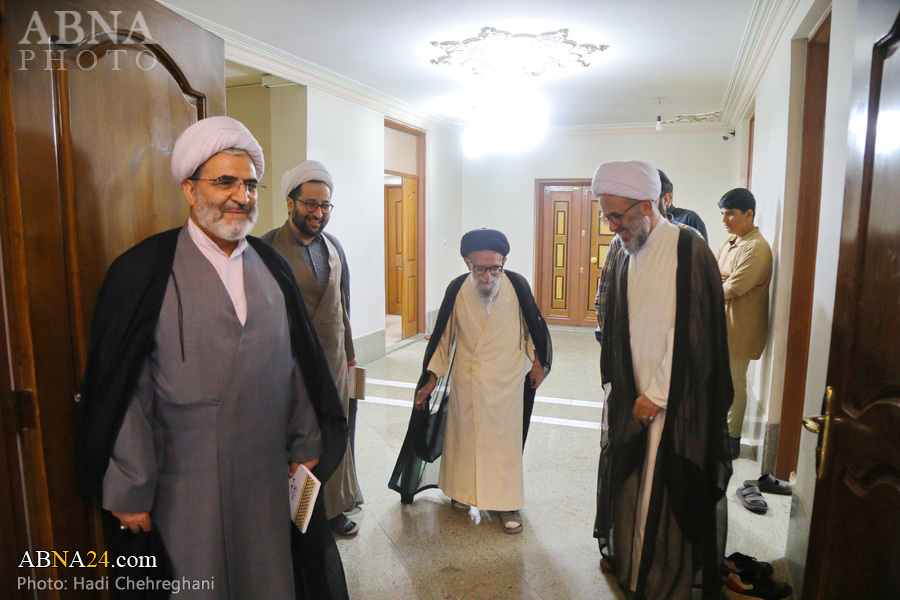
In cooperation with researchers, our view is not materialistic
Regarding the availability of copies of the Center for the Revival of Islamic Heritage for researchers, Ayatollah Eshkevari stated, “The budget of cultural institutions is provided by the government, Marjaiat, or the people. Therefore, these institutions should be available to the people, and in this regard, obstacles and formalities should be removed. If a student or clergy requests a copy from the Center for Revival of Islamic Heritage, we do not ask him for a letter of introduction and we cooperate with him. Because most seminarians and students do not have financial means. Therefore, we should not have a commercial purpose in cooperating with them. For this reason, although we prepare the photographs [of the books] at a high cost, we provide them to the researchers at a very low price. For example, I traveled to Italy to make 190 photocopies of the Great Vatican Library. I was there for 14 days, and our expenses were heavy. In cooperation with researchers, our view is not materialistic.”
“The beauty and attractiveness of different parts of the Center for Revival of Islamic Heritage is one of the advantages of this institute,” he added, “In Iran, you will not find anywhere like this center that has such beautiful halls. I was friends with Mr. Mohammad Reza Hakimi. Once, he came to the center and saw the Hall of Researchers and said, “It’s a pity that I’m old now, otherwise I wouldn’t have left here.”
“One of our innovative works is the establishment of the museum of old writing instruments in the center for the revival of Islamic heritage,” the Shiite bibliographer and cataloger of manuscripts added, “Historical tools such as pens, scissors, knives, etc. are displayed in this museum.”
To be connected with the world, we need to write in Arabic
“All notes and emendations of the works are in my own handwriting. From Karbala, I was asked to work on a booklet, and today I read it for the third time to finalize it. Therefore, I do everything personally. I have never touched a computer. In a detailed interview on Channel One of IRIB, the host asked me about the computer. Answering that “the computer is one of the enemies of science”, I explained my reasons,” he said about his research method.
On the importance of the Arabic language Ayatollah Eshkevari stated, “Most of my works and writings are in Arabic. I believe that in order to be connected to the world, we need to write in Arabic, not just in Persian. I have been connected with prestigious universities in the world. There, the students of Oriental Studies, and Islamic Studies said, “We go to Damascus or Cairo for a few months to learn Arabic. Because our study resources are in Arabic”.”
“To introduce our culture to the world, our works must be in Arabic,” he added, “Some people think that I am against the Persian language, but I am proud of being a Shiite and an Iranian.”
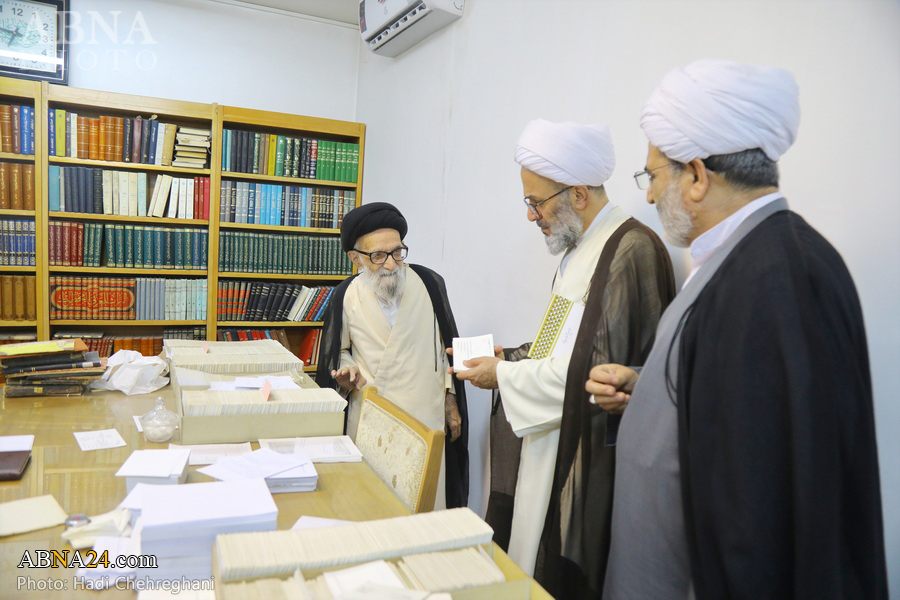
The main problem of the Iranian catalogers
Regarding the fundamental problem of Iranian catalogers in the Islamic world, the Shiite bibliographer and cataloger of manuscripts stated, “In Arab countries, they asked me whether we have a library of manuscripts in Iran! This is while I believe that Iran is a sea of handwritten books. But our problem is that the catalogers in Iran only say that they should guard Persian, and they have not introduced our heritage to the world in other languages. Therefore, I wrote the collection “Heritage of Arabic Manuscripts in Public Libraries of Iran” in fourteen volumes, which is well known in the country today. Therefore, our writing in Arabic should be up to date so that everyone can understand it.”
Then, the directors of AhlulBayt (a.s.) World Assembly visited different parts of the Center for Revival of Islamic Heritage, and Ayatollah Sayed Ahmad Hosseini Eshkevari provided explanations about each section.
.......................
End/ 345
Among the tasks defined for the AhlulBayt (a.s.) World Assembly, is to preserve the Shiite heritage and works, identify capacities, and create areas of cooperation and interaction between the Assembly and Shiite centers. The Center for the Revival of Islamic Heritage, headed by Ayatollah Eshkevari, is one of the organizations that have the mission of reviving ancient Shiite works.
ABWA Official Website – Increasing communication with active centers and institutions about AhlulBayt (a.s.), as well as creating fields of cooperation and using their capacities, is the approach of the AhlulBayt (a.s.) World Assembly in the new management period. In this regard, on Sunday, June 18, 2023, a group of directors of the Assembly visited the Center for the Revival of Islamic Heritage, headed by Ayatollah Sayed Ahmad Hosseini Eshkevari.
Ayatollah Sayed Ahmad Hosseini Eshkevari is a prominent professor and researcher of Shiite works who, at 92 years old, works 24/7 for the revival of Shiite heritage with the vigor of youth. Ayatollah Eshkevari, who is just an old man at first glance, when he takes the lead for explanations about every corner of the Center for the Revival of Islamic Heritage, his will, extraordinary memory, and unparalleled mastery are completely evident.

A report of the activities of the AhlulBayt (a.s.) World Assembly
At the beginning of the visit, the adviser to the Secretary General of the AhlulBayt (a.s.) World Assembly on Seminary and Clergy Affairs, presented a report on the activities of this international organization in various fields.
While considering addressing the situation of the Shiites of the world as the main mission and task of the AhlulBayt (a.s.) World Assembly, Hojat al-Islam Abdullah Tavana stated, “Among the tasks defined for the AhlulBayt (a.s.) World Assembly, is to preserve the Shiite heritage and works. Therefore, it is important to identify the capacities and create areas of cooperation and interaction between the AhlulBayt (a.s.) World Assembly and the Center for the Revival of Islamic Heritage.”
Tavana also presented a report on holding the “International Conference of Hazrat Abu Talib (a.s.); Supporter of the Great Prophet (p.b.u.h)” by the Assembly and the publication of a 25-volume encyclopedia of the works of this conference.

The works of the “Center for Revival of Islamic Heritage” focused on Bibliography and Shiite Ulama fields of study
Further in the visit, describing the main activities of the “Center for the Revival of Islamic Heritage”, Ayatollah Seyyed Ahmad Hosseini Eshkevari, the president and founder of the center said, “I have been engaged in heritage-related activities since the age of thirty, and in sixty years, three hundred volumes of these works have been published, eighty of which are devoted to manuscript indexes. I have traveled to many countries, and seen great libraries up close, and my recent heritage-related work, Al-Mualaffat al-Imamiyah (the Compilations of Imamiyah), will be published in 21 volumes in Karbala.”
“Most of my works are in Bibliography and Shiite Ulama fields of study,” he added, “My activities are in the Shiite framework.”
“I care a lot about discipline and order in doing works,” the Shiite bibliographer and cataloger of manuscripts added, “In addition to the publication of books, I care a lot about their distribution, and I have even paid close attention to the attractiveness of the building of the Center for the Revival of Islamic Heritage.”
On the establishment history of the Center for the Revival of the Islamic Heritage, he said, “In the Congress “Books and Bibliography in Islamic Civilization” of the Holy Shrine of Imam Reza (a.s.), in a short speech I said, “We must establish a center in which copies of Shiite books from all over the world can be photographed and made available to clerics and students. Therefore, I presented an institutional plan for this work. There, Hojat al-Islam Sayed Javad Shahrestani (representative of Ayatollah Sistani) and Mr. Aziz Tabatabai said, “This is a good suggestion, and you should do it yourself.” After discussions, the Center for Revival of Islamic Heritage was established in a basement with an area of eighteen square meters. Today, after nearly 30 years of activity, more than 200,000 copies from different countries have been photographed in this center, 12,000 manuscripts have been purchased, and 8,000 documents are also available in the center. Also, for manuscripts, 16 volumes of the Persian index have been prepared, of which the 17th volume is about to be printed. Also, for manuscripts, 9 volumes of catalogs have been printed.”

In cooperation with researchers, our view is not materialistic
Regarding the availability of copies of the Center for the Revival of Islamic Heritage for researchers, Ayatollah Eshkevari stated, “The budget of cultural institutions is provided by the government, Marjaiat, or the people. Therefore, these institutions should be available to the people, and in this regard, obstacles and formalities should be removed. If a student or clergy requests a copy from the Center for Revival of Islamic Heritage, we do not ask him for a letter of introduction and we cooperate with him. Because most seminarians and students do not have financial means. Therefore, we should not have a commercial purpose in cooperating with them. For this reason, although we prepare the photographs [of the books] at a high cost, we provide them to the researchers at a very low price. For example, I traveled to Italy to make 190 photocopies of the Great Vatican Library. I was there for 14 days, and our expenses were heavy. In cooperation with researchers, our view is not materialistic.”
“The beauty and attractiveness of different parts of the Center for Revival of Islamic Heritage is one of the advantages of this institute,” he added, “In Iran, you will not find anywhere like this center that has such beautiful halls. I was friends with Mr. Mohammad Reza Hakimi. Once, he came to the center and saw the Hall of Researchers and said, “It’s a pity that I’m old now, otherwise I wouldn’t have left here.”
“One of our innovative works is the establishment of the museum of old writing instruments in the center for the revival of Islamic heritage,” the Shiite bibliographer and cataloger of manuscripts added, “Historical tools such as pens, scissors, knives, etc. are displayed in this museum.”
To be connected with the world, we need to write in Arabic
“All notes and emendations of the works are in my own handwriting. From Karbala, I was asked to work on a booklet, and today I read it for the third time to finalize it. Therefore, I do everything personally. I have never touched a computer. In a detailed interview on Channel One of IRIB, the host asked me about the computer. Answering that “the computer is one of the enemies of science”, I explained my reasons,” he said about his research method.
On the importance of the Arabic language Ayatollah Eshkevari stated, “Most of my works and writings are in Arabic. I believe that in order to be connected to the world, we need to write in Arabic, not just in Persian. I have been connected with prestigious universities in the world. There, the students of Oriental Studies, and Islamic Studies said, “We go to Damascus or Cairo for a few months to learn Arabic. Because our study resources are in Arabic”.”
“To introduce our culture to the world, our works must be in Arabic,” he added, “Some people think that I am against the Persian language, but I am proud of being a Shiite and an Iranian.”

The main problem of the Iranian catalogers
Regarding the fundamental problem of Iranian catalogers in the Islamic world, the Shiite bibliographer and cataloger of manuscripts stated, “In Arab countries, they asked me whether we have a library of manuscripts in Iran! This is while I believe that Iran is a sea of handwritten books. But our problem is that the catalogers in Iran only say that they should guard Persian, and they have not introduced our heritage to the world in other languages. Therefore, I wrote the collection “Heritage of Arabic Manuscripts in Public Libraries of Iran” in fourteen volumes, which is well known in the country today. Therefore, our writing in Arabic should be up to date so that everyone can understand it.”
Then, the directors of AhlulBayt (a.s.) World Assembly visited different parts of the Center for Revival of Islamic Heritage, and Ayatollah Sayed Ahmad Hosseini Eshkevari provided explanations about each section.
.......................
End/ 345
